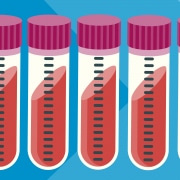Researchers devise single test to rapidly pinpoint a fever’s cause
One test looking at many possible causes of a fever could help clinicians quickly diagnose very unwell children
Researchers have developed a new gene expression test that looks at which genes are turned on or off (expressed) in response to different diseases. They want to help clinicians identify the cause of a fever in just a couple of hours.
Reporting their findings in the journal Med last month, the researchers noted that their test could pick out the reason behind the fever for 18 conditions, with a 90% accuracy.
Finding a fever’s cause is hard
Many different illnesses can cause fevers in children. As such, it can be difficult for doctors to establish the cause when a sick child is brought into hospital. This can be a matter of urgency, as delays in starting treatment can result in poorer outcomes.
“As clinicians, we need to make rapid decisions on treatment, often just based on the child’s symptoms, information from the parents, and our medical training and experience,” said Imperial College London’s chair of paediatrics and co-author Professor Michael Levin. “But we may not know whether a fever is bacterial, viral, or something else until hours or days after a child has been admitted, when their test results come back.”
He added: “Such delays can stop patients getting the right treatment early on, so there is a clear and urgent need to improve diagnostics.”
A different kind of diagnostic test
The gene expression test works on a different basis from existing diagnostic approaches. Current lateral flow tests and blood cultures look for the presence of an infectious agent, such as a bacteria or virus. Instead, this test looks for patterns in patient gene expression that can act as clues as to what is causing the symptoms.
The idea is that, with a single blood sample, clinicians can look for many different possible causes of a fever at once. This avoids individually testing for different bacteria and viruses, as well as other inflammatory conditions.
The test was developed by looking at RNA transcriptome data from more than a thousand patients. This established which genes are switched on or off in response to different diseases. The result is a 161-gene panel, which can diagnose across a range of 18 different fever-causing conditions and with 90% accuracy.
Rapid testing helps prescribing decisions
While the previously mentioned lateral flow tests can provide rapid responses for some infectious agents – for instance, the virus that causes Covid-19 – each of those tests can provide a result for only a single type of illness. Additionally, some types of bacterial infections need a blood culture test; these can take days to return a result.
While tests are being run, clinicians often start patients on broad-spectrum antibiotics. This action can be lifesaving for some, but unnecessary for others, and may contribute towards the rise of antibiotic-resistant bacteria. The researchers who developed this new test say it can return results within an hour, reducing the overuse of antibiotics.
“A future diagnostic test based on this approach could help provide the right treatment, to the right patient, at the right time, while optimising antibiotic use, and reducing lengthy time to diagnosis for inflammatory diseases,” said Imperial College London bioinformatician and co-author Dr Myrsini Kaforou.
Looking to the future
The test has not yet been approved for use in clinical settings and so the team are working on developing an easy-to-use version that could be used routinely in the NHS.
The test will also be analysed against current approaches in hospitals in Europe, Africa and Asia to see how useful it will be in clinical decision-making.









